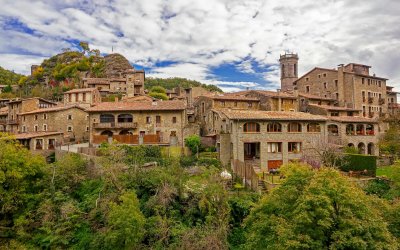Exploring Montjuïc mountain is a must-do experience in Barcelona. In addition to its amazing views of the city and swathes of green space, it is home to significant heritage sites. On Montjuïc mountain, you’ll find plenty of museums and other notable cultural facilities, many of which have signed up to the Destination Barcelona Commitment to Sustainable Tourism scheme, an initiative aimed at fostering a type of tourism that respects the local environment and its people. Today, we’re bringing you a route designed to offer you an activity-packed day discovering this magical mountain while enjoying culture in a sustainable way.
1. Poble Espanyol
The day begins at Poble Espanyol (literally, Spanish town), an open-air heritage site where the architecture of different parts of Spain has been recreated. As you wander its streets, you’ll come across everything from typical Andalusian neighbourhoods to Catalan Romanesque monasteries or Castilian squares. Built for the 1929 Barcelona International Exposition, this iconic site has preserved its original spirit while evolving to offer a wide variety of gastronomic, cultural and leisure experiences. But the overriding characteristic of Poble Espanyol is its goal to preserve and showcase the city’s history, culture and heritage.
As you make your way around the site, you’ll get the chance to see master artisans in action and to take part in workshops and experience their crafts first-hand. And don’t miss the chance to visit the museum of the Fran Daurel Foundation, housed within the site, which displays works by world-famous artists including Pablo Picasso, Salvador Dalí, Joan Miró, Antoni Tàpies or Eduardo Chillida.
2. Mies van der Rohe Foundation
The Mies van der Rohe Foundation, just a few minutes’ walk away, is dedicated to the preservation and dissemination of modern architecture. There, you can immerse yourself in a reconstruction of the German Pavilion built for the 1929 Barcelona International Exhibition, designed by Ludwig Mies van der Rohe and Lilly Reich. This masterpiece of modern architecture, with its use of pure lines and materials such as glass, steel, and marble, has been profoundly influential on subsequent architecture.
In addition to offering exhaustive guided tours of this iconic site, the foundation organises artistic interventions that interact with the pavilion’s architecture, all with the goal of preserving and growing van der Rohe’s legacy for future generations.
3. National Art Museum of Catalonia (MNAC)
The next stop on our cultural trip is the MNAC, a museum which, besides boasting an exceptional collection, is housed in the spectacular Palau Nacional (National Palace), set in majestic gardens and affording one of the finest panoramic views of Barcelona. The MNAC takes you on a journey through Catalan art spanning a thousand years of history, and featuring one of the world’s most outstanding collections of Romanesque art. It also displays Catalan modernist pieces, with examples of decorative and interior design from remarkable architectural heritage sites such as Casa Batlló and Casa Amatller, along with a broad display of avant-garde art that reflects artistic trends from the post-war period through to the 1960s.
The museum prioritises accessibility, providing ramps, lifts and adapted guides to ensure a comfortable experience for all visitors.
4. Joan Miró Foundation
Next we come to the Joan Miró Foundation. Created by Miró himself with the aim of bringing contemporary art to everyone, it houses the world’s largest collection of the artist’s works, as well as important pieces by other contemporary artists (an exhibition featuring paintings by Matisse is currently on there, for example). The building itself is also a work of art. Designed by the architect Josep Lluís Sert, a close friend of Miró, it is conceived as an open space with both interior and exterior terraces that allow visitors to move around freely.
Here, we can take part in activities for the whole family and experience art in an inclusive and accessible way. Access is provided to materials and programmes adapted for people with different needs, offering a multisensory experience so that everyone can enjoy the museum on equal terms.
5. Teatre Lliure, Montjuïc
We end the day at the Teatre Lliure, one of Spain’s leading centres for the performing arts. With a programme comprising much-loved classics (this season’s must-sees include Molière’s The Misanthrope and Chekhov’s The Seagull) and contemporary drama, the Teatre Lliure is committed to a culturally and socially responsible approach.
Its Montjuïc venue is housed in the historic former Palau de l’Agricultura (Palace of Agriculture), which, like all the buildings we’ve seen on the route, except for the Joan Miró Foundation, was built for the 1929 Barcelona International Exposition. The theatre comprises the Sala Fabià Puigserver, which is equipped with the latest stage technology and can seat up to 720 patrons, and the smaller Espai Lliure (up to 172 patrons).
A leader in accessibility, the Lliure schedules performances with adapted subtitles, audio description and simultaneous translation in Catalan sign language, along with sessions specifically catering for people with autism spectrum disorders. It has also implemented a sustainability plan to reduce the environmental impact of its activities, aiming to show that the arts can contribute positively to the fight against climate change.
Taking in everything from mediaeval art to modern architecture, the avant-garde and the performing arts, this route gives you the chance to rediscover the magical mountain from a new perspective. Moreover, the adoption of the Destination Barcelona Commitment to Sustainable Tourism seal means that a conscious and accessible experience is guaranteed for one and all.











